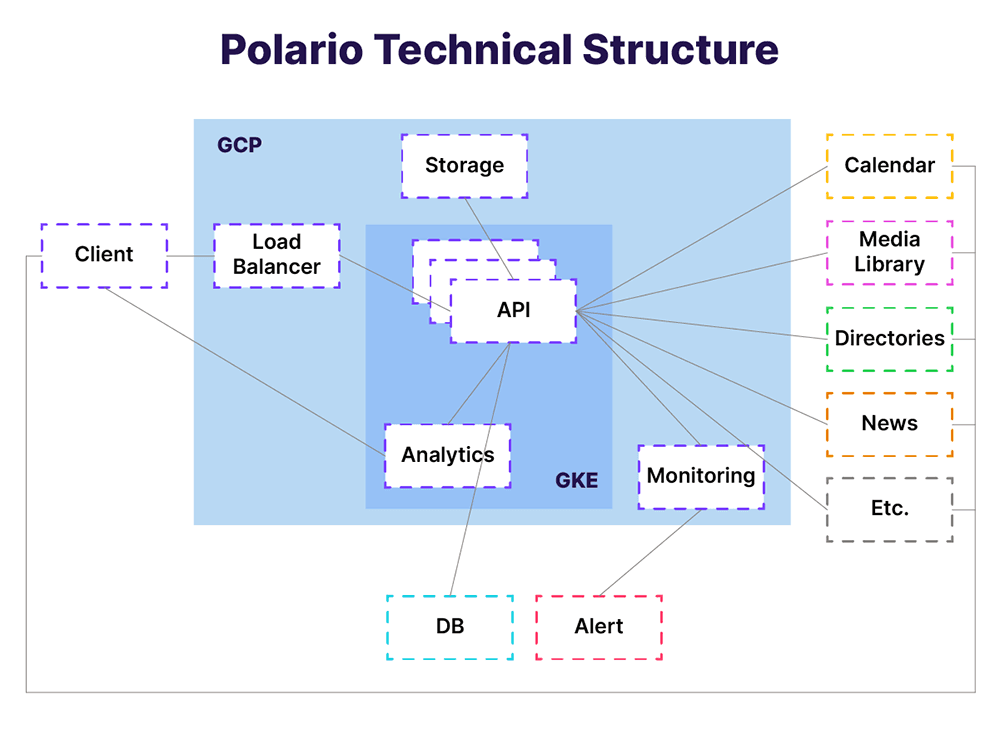“We remain convinced that we can achieve the best possible level of usability and performance in the apps.” – R. L. Wilkening, CTO plazz AG
Our new app Polario is in the starting blocks! For this, we are starting a mini-blog series in the form of an interview series. For the launch, we start with the technical foundations of the app. We asked our CTO Ronja Lars Wilkening a few questions about what’s behind Polario. He gives us a little peek under the hood of our SaaS solution and tells us its added value.
Interview – Technical Foundation
Hello Ronja, please introduce yourself.
Hello. First of all, thank you for letting me tell you about the exciting new features in our new generation of products. My name is Ronja Lars Wilkening and I have been allowed to accompany the history of plazz for 10 years now. I have been involved in the product development of our Mobile Event App from the very beginning and as CTO I have contributed to the success of the product over the past years. Now, with Polario, we are taking the quality of our solution to a whole new level and we are all tremendously excited and looking forward to getting feedback from our customers.

CTO at plazz AG
Give us an insight and some info about the technical foundation of the app and Polario’s content management system.
plazz AG is already very experienced with the development of mobile apps. We initially implemented many custom solutions, but of course also put several years of development into the Mobile Event App. We are still convinced that we can achieve the best possible level of usability and performance in the apps. How do we achieve this? By staying as close as possible to the smartphone manufacturers’ tech stack. This way, we implement the user interface paradigms true to the platform and can intensively use the existing operating system interfaces and basic technologies. By developing mobile apps natively, we deliver a solid app that fits beautifully into the user’s environment on their smartphone.
With web interfaces, such as our webapp and the content management system, the story is not so clear-cut. Here, diverse operating systems and browsers used for access set the most varied framework conditions, whereby the web standards abstract the interfaces on a different level. Thus it is up to the developers themselves to weigh up the so-called frameworks and make a good choice for their own use case. For our web applications, we rely in Polario on
What is special about Polario’s architecture?
With the technical foundation of Polario, we are on the cutting edge. In many respects, we are certainly a good deal ahead of most other software solutions. Nevertheless, it is important to us to guarantee our customers a robust, solid and reliable service.
A central building block to meet this requirement is a container-based approach that divides the server-side application components in such a way that they are functionally separate. This results in several modular systems (“services”) that interlock with each other. Each system in itself is much less complex and requires fewer technical resources. This makes it easier for us to ensure the quality and maintenance of the individual services, and when the load increases (e.g. during events), we can increase the computing capacity exactly where it is needed. With a monolithic all-in-one solution, scaling the systems is also possible, but you often waste capacities that are not actually needed on this scale.
However, our product also differs strongly from many other SaaS solutions on the market in one respect. Since we offer our solution as a white labelplatform in the corporate sector, we place particular emphasis on compliance, such as the clearest possible client separation. For us, this means that the data of different customers is not only clearly stored separately from each other, but also processed separately. The services of our customer environments have separate containers in which they are executed and we can therefore ensure a very high degree of client separation.
Were there parallels to the MEA?
Were you able to adopt elements/components of the MEA?
As with the mobile event app, we are relying on native apps on the front end. Otherwise everything under the hood is new. We are using a modern tech stack across the board and have gotten rid of all legacy components, such as outdated programming languages or poorly maintained third-party components. This means we are well equipped for the future and are starting the market launch with the best state-of-the-art technologies.
What were your learnings from working with the MEA?
The Mobile Event App is a great product in and of itself. We have invested a lot of commitment and love into it to get the software to where it is today. I am also convinced that we can currently also serve ongoing and further customer projects well with the solution. We have done many things really well and our customers regularly show us this with overwhelmingly good feedback.
Nevertheless, there are of course issues where we wanted to position ourselves better for the future. This was also the main driver for Polario. Both technologically and conceptually, we have created new technical foundations that will allow our customers to use our solution in the long term and will be able to map a variety of customer use cases. While some of the features of the Mobile Event App were very specific and rigid, we are now making them much more flexible so that our customers can tailor their individual implementations more precisely.
Overall, we are well prepared to serve even larger numbers of participants at events and to provide users with great added value.
Please describe your basic approach.
While we focused on simple technical solutions in the Mobile Event App in the sense of a lean development approach, we are building our new product generation on completely different technical foundations. On the technical side, we place much more emphasis on robustness, performance, scalability and automation. But, of course, when it comes to the security of the system, we continue to evolve.
Not only from the technical side, our new product should allow our customers more independence, but also through a good usability of self-explanatory user interfaces, we want to enable our customers to quickly and independently gain access to our system and quickly successfully implement their projects.
But this does not mean that we cut back our service. Of course, we remain the direct contact for our customers at all times. In case of questions, we will continue to accompany them directly to the project implementation.
Were certain or even new development rules applied in the process?
We have greatly optimized the processes in development. Starting with the establishment of clean quality assurance structures in the form of automated tests and code analyses to controlled change management processes through a clear Git branching flow to streamlining our agile methods to achieve even faster and better work results.
To what extent have you been responsive to user needs?
In product design, we were able to draw a lot from our experience with the Mobile Event App. Our customer service was always the channel for
What challenges did you face in creating and implementing the app and CMS?
One challenge we face in the development of Polario is the benchmark with the Mobile Event App. Our customers are used to a large range of functions, in the app and content management system, and we have to measure our new product against this. We meet this challenge by trying to design as generalistic and flexible features as possible that our customers can use in a wide variety of ways. With the feature set that we can offer at the start, a large number of the previous and even some additional user cases can already be covered.


